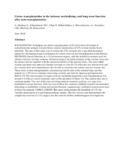| dc.contributor.author | A., Enskog | |
| dc.contributor.author | L., Johannesson | |
| dc.contributor.author | D.C., Chai | |
| dc.contributor.author | P., Dahm-Kähler | |
| dc.contributor.author | J, Marcickiewicz | |
| dc.contributor.author | A., Nyachieo | |
| dc.contributor.author | J.M., Mwenda | |
| dc.contributor.author | M, Brännström | |
| dc.date.accessioned | 2013-07-09T10:47:47Z | |
| dc.date.available | 2013-07-09T10:47:47Z | |
| dc.date.issued | 2010 | |
| dc.identifier.citation | A. Enskog, L. Johannesson, D.C. Chai, P. Dahm-Kähler, J. Marcickiewicz, A. Nyachieo, J.M. Mwenda and M. Brännström; Uterus transplantation in the baboon: methodology and long-term function after auto-transplantation;February 9, 2010. | en |
| dc.identifier.uri | http://humrep.oxfordjournals.org/content/25/8/1980.short | |
| dc.identifier.uri | http://erepository.uonbi.ac.ke:8080/xmlui/handle/123456789/46688 | |
| dc.description.abstract | BACKGROUND Techniques for uterus transplantation (UTx) have been developed in rodent/domestic animals towards future clinical introduction of UTx to treat uterine factor infertility. The aim of this study was to extend the UTx research into a non-human primate species by developing surgical techniques for uterus retrieval and transplantation in the baboon.
METHODS Female baboons (n = 15) underwent surgery, with the initial five animals used for studies of pelvic vascular anatomy. Retrieval surgery included isolation of the ovarian veins and the uterine arteries together with the anterior branches of the internal iliacs. The utero-tubal-ovarian specimen was removed, flushed and kept ex vivo for 2 h when the two arterial ends and two venous ends were anastomosed side-to-side to construct one arterial and one venous end. These were, at auto-transplantation, anastomosed end-to-side to the external iliacs and the animals (n = 10) were evaluated concerning cyclicity and later by laparoscopy/laparotomy.
RESULTS The total duration of organ retrieval, backtable preparation and transplantation was around 6 h with an overall ischaemic time of the specimen of about 3 h. One animal died due to cardiomyopathy. Five out of the nine surviving animals resumed cyclicity, as a sign of re-established ovarian function. Only two out of these five animals exhibited resumed menstruation, indicating re-established ovarian and uterine function. Laparoscopy confirmed normal-sized uteri in these two animals.
CONCLUSIONS This study demonstrates the feasibility of UTx by vascular anastomosis in a non-human primate species. The low success rate demonstrates the complexity involved in UTx surgery and the need for further methodological developments. | en |
| dc.language.iso | en | en |
| dc.publisher | University of Nairobi, | en |
| dc.subject | baboon | en |
| dc.subject | infertility | en |
| dc.subject | transplantation | en |
| dc.subject | uterus | en |
| dc.title | Uterus transplantation in the baboon: methodology and long-term function after auto-transplantation | en |
| dc.type | Article | en |
| local.publisher | College of Health Sciences, | en |

